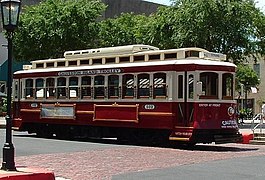Galveston Island Trolley
| Galveston Island Trolley | |
|---|---|
 | |
| Overview | |
| Status | Service suspended. Resumption pending return of the restored trolleys |
| Owner | City of Galveston |
| Locale | Galveston, Texas |
| Stations | 22 |
| Website | Island Transit |
| Service | |
| Type | Heritage streetcar |
| Services | 1 |
| Operator(s) | Island Transit |
| Depot(s) | Trolley Maintenance Facility |
| Rolling stock | 4 Miner Railcar replica trolleys |
| History | |
| Opened | July 23, 1988 |
| Closed | September 2008 |
| Technical | |
| Line length | 6.8 miles (10.9 km) |
| Character | street-running |
| Track gauge | 4 ft 8+1⁄2 in (1,435 mm) |
| Electrification | none |
The Galveston Island Trolley is a heritage streetcar in Galveston, Texas, United States. As of late 2006, the total network length was 6.8 miles (10.9 km) with 22 stations. The Galveston Island Trolley is operated by Island Transit. The rail system has not been operational in over a decade (since 2008), when the city was hit by Hurricane Ike and its total fleet of five rail cars and its 6.8 miles of track were severely damaged. Subsequently, the Federal Emergency Management Agency (FEMA) and the Federal Transit Administration have agreed to fund repairs.[1][dead link] In January 2017, a contract was approved to restore three of the trolleys at a cost of $3.8M.[2] At that time, the trolleys were expected to be ready to return to service in 2018,[3][4] but the date was later postponed to 2019[5] and later to 2021. As of November 2020 two reconditioned trolleys have returned to Galveston, but the system still isn't yet operational.[6]
History[]
Galveston has had streetcars before. The first urban rail public transit system was introduced in 1867. The cars were pulled by mules. In 1891 electric trolleys were introduced. They remained in service until May 1938.
Galveston Island Trolley, a heritage streetcar system, was opened on July 23, 1988.[7] Barry Goodman Associates (now the Goodman Corporation) was a key consultant in the creation of the Trolley, leading the early design studies and helping to secure funding. The project was designed by HNTB, engineers, who were responsible for all aspects of track and vehicle design; Ochsner Associates, architects, who were responsible for the maintenance facility and the passenger shelter (on 20th Street).
Initially, the Galveston Island Trolley connected the historic Strand District on the north side of Galveston Island with the Seawall beach area. It was mainly used by tourists. In the 1990s planning for an extension of the line began and it was extended in 1995.[7] A new branch to the University of Texas Medical Branch (UTMB) opened on March 14, 2005.[7] This line was popular among UTMB staff, students and patients.[citation needed]
Rolling stock[]
The Galveston Island Trolley cars look like vintage electric trolleys, but actually they are modern build and diesel-electric powered. Therefore, there are no overhead wires. This means that the vehicles are not technically trolleys since they do not "troll" for power from overhead wires, but are streetcars.
The Galveston trolley fleet consists of four cars. All of them are identical, though they are painted in different colors. The cars were built by Miner Railcar, Pennsylvania.[8] Each car can accommodate up to 80 passengers; 40 sitting and 40 standing. Cars are designed for an operational speed of 25 mph (40 km/h). Each car weighs 63,000 lb (29,000 kg).[8]
In 2005, all cars were equipped with air conditioning.
Between 2017 and 2021 three of the cars were extensively restored by Gomaco Trolley Co.[6]
Hours of operation[]
Service has been suspended since 2008 when the cars and tracks substained heavy damage from Hurricane Ike. Substitute service with replica buses was later put into place and is still ongoing. The trolley system formerly operated on a daily schedule using one car on weekdays and two cars on weekends. It is expected that three of the restored trolleys will be returned to Galveston in 2020.
References[]
- ^ Rhiannon Meyers. "FEMA to pay $200 million for infrastructure". Galveston County Daily News. Retrieved January 8, 2010.
- ^ Samantha Ketterer (January 26, 2017). "On the road again: Galveston City Council approves trolley contract". Galveston County Daily News. Retrieved January 28, 2017.
- ^ Bryan Kirk (March 24, 2017). "Trolley makes comeback to Galveston Island". Patch.com. Retrieved April 2, 2017.
- ^ Darla Guillen (March 24, 2017). "Trolley-buses to roll into Galveston by Mid-May". www.masstransit.org. Archived from the original on April 3, 2017. Retrieved September 28, 2018.
- ^ Tony Brooks, John Wayne Ferguson (September 16, 2018). "Under repair in Iowa, trolleys could roll again in 2019". Galveston County Daily News. Archived from the original on September 17, 2018. Retrieved September 28, 2018.
- ^ Jump up to: a b Roane, Lee (October 23, 2020). "Shiny Red Historic Trolley 502 Arrives". www.galveston.com. Retrieved November 21, 2020.
- ^ Jump up to: a b c "Island Transit Information". Island Transit. Retrieved August 21, 2013.
- ^ Jump up to: a b Wilkins, Van (Spring 1996). "Heritage Trolleys in Memphis and Galveston". The New Electric Railway Journal. Free Congress Foundation. ISSN 1048-3845. Retrieved May 27, 2011.
- Jon Bell: Galveston Island Trolley
- Trams 2007 by B.A. Schenk and M.R. Van Den Toorn. Alk publishings, Netherlands, ISBN 90-6013-466-4 (book in Dutch)
- RPR Consulting: Galveston Island Trolley
External links[]
- 1988 establishments in Texas
- Heritage railroads in Texas
- Heritage streetcar systems
- Transportation in Galveston, Texas
- Tourist attractions in Galveston, Texas
- Railway lines opened in 1988
- Railway lines closed in 2008
